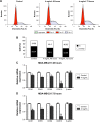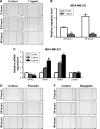Extracts and components of Ficus carica leaves suppress survival, cell cycle, and migration of triple-negative breast cancer MDA-MB-231 cells
- PMID: 30100743
- PMCID: PMC6067789
- DOI: 10.2147/OTT.S171601
Extracts and components of Ficus carica leaves suppress survival, cell cycle, and migration of triple-negative breast cancer MDA-MB-231 cells
Abstract
Background: Products from Ficus carica have been used in traditional medicine to treat many diseases. This study aimed to analyze anticancer effects of extracts of F. carica leaves on the triple-negative breast cancer cell line MDA-MB-231.
Materials and methods: The human breast cancer cell line MDA-MB-231 was used to evaluate effects of F. carica extracts. Effects of F. carica on cell viability were evaluated using MTT assays. Cell-cycle distribution was examined using cell-cycle analysis. Wound-healing assays were used to evaluate migration of MDA-MB-231. Quantitative reverse-transcription polymerase chain reaction was used to detect levels of Bax, p53, p21, GATA3, ELF5, cyclin-dependent kinases, MMP2, and tissue inhibitors of metalloproteinase.
Results: We investigated the mechanism of anti-growth effects, and found that the expressions of genes that promote apoptosis were increased. In addition, the treated cells illustrated increased portion at S phase and changed expression of cyclin-dependent kinases, demonstrating cell-cycle arrest at the S phase. Furthermore, treated cells showed decreased cell mobility, which is essential for metastasis. Two of the active components of F. carica leaves, bergapten and psoralen, had similar anticancer effects as F. carica leaf extracts, indicating that these two components might play important roles in anticancer effects of F. carica leaves.
Conclusion: Our findings suggest that F. carica leaves might be a good source to develop drugs for suppressing cancer-cell growth and migration to treat triple-negative breast cancers.
Keywords: Ficus carica; MDA-MB-231; breast cancer; migration.
Conflict of interest statement
Disclosure The authors report no conflicts of interest in this work.
Figures





Similar articles
-
Comparative anticancer activities of Ficus carica and Ficus salicifolia latex in MDA-MB-231 cells.Saudi J Biol Sci. 2021 Jun;28(6):3225-3234. doi: 10.1016/j.sjbs.2021.02.061. Epub 2021 Feb 24. Saudi J Biol Sci. 2021. PMID: 34121859 Free PMC article.
-
Functions, accumulation, and biosynthesis of important secondary metabolites in the fig tree (Ficus carica).Front Plant Sci. 2024 Jul 2;15:1397874. doi: 10.3389/fpls.2024.1397874. eCollection 2024. Front Plant Sci. 2024. PMID: 39022605 Free PMC article. Review.
-
Phytochemical profile and antiproliferative effect of Ficus crocata extracts on triple-negative breast cancer cells.BMC Complement Med Ther. 2020 Jun 22;20(1):191. doi: 10.1186/s12906-020-02993-6. BMC Complement Med Ther. 2020. PMID: 32571387 Free PMC article.
-
Anticancer Effect of Citrus hystrix DC. Leaf Extract and Its Bioactive Constituents Citronellol and, Citronellal on the Triple Negative Breast Cancer MDA-MB-231 Cell Line.Pharmaceuticals (Basel). 2020 Dec 18;13(12):476. doi: 10.3390/ph13120476. Pharmaceuticals (Basel). 2020. PMID: 33353129 Free PMC article.
-
Traditional uses, phytochemistry and pharmacology of Ficus carica: a review.Pharm Biol. 2014 Nov;52(11):1487-503. doi: 10.3109/13880209.2014.892515. Epub 2014 Jul 14. Pharm Biol. 2014. PMID: 25017517 Review.
Cited by
-
Crude Edible Fig (Ficus carica) Leaf Extract Prevents Diethylstilbestrol (DES)-Induced DNA Strand Breaks in Single-Cell Gel Electrophoresis (SCGE)/Comet Assay: Literature Review and Pilot Study.J Bioequivalence Bioavailab. 2019;11(2):19-28. doi: 10.35248/0975-0851.19.11.389. Epub 2019 Apr 1. J Bioequivalence Bioavailab. 2019. PMID: 31814674 Free PMC article.
-
Comparative anticancer activities of Ficus carica and Ficus salicifolia latex in MDA-MB-231 cells.Saudi J Biol Sci. 2021 Jun;28(6):3225-3234. doi: 10.1016/j.sjbs.2021.02.061. Epub 2021 Feb 24. Saudi J Biol Sci. 2021. PMID: 34121859 Free PMC article.
-
Evaluation of the Biological Effect of Non-UV-Activated Bergapten on Selected Human Tumor Cells and the Insight into the Molecular Mechanism of Its Action.Int J Mol Sci. 2023 Oct 25;24(21):15555. doi: 10.3390/ijms242115555. Int J Mol Sci. 2023. PMID: 37958539 Free PMC article.
-
In Vitro Anticancer Potential of Berberis lycium Royle Extracts against Human Hepatocarcinoma (HepG2) Cells.Biomed Res Int. 2020 Oct 14;2020:8256809. doi: 10.1155/2020/8256809. eCollection 2020. Biomed Res Int. 2020. PMID: 33110920 Free PMC article.
-
Functions, accumulation, and biosynthesis of important secondary metabolites in the fig tree (Ficus carica).Front Plant Sci. 2024 Jul 2;15:1397874. doi: 10.3389/fpls.2024.1397874. eCollection 2024. Front Plant Sci. 2024. PMID: 39022605 Free PMC article. Review.
References
-
- Barolo MI, Mostacero NR, López SN. Ficus carica L. (Moraceae): an ancient source of food and health. Food Chem. 2014;164:119–127. - PubMed
-
- Jing L, Zhang YM, Luo JG, Kong LY. Tirucallane-type triterpenoids from the fruit of Ficus carica and their cytotoxic activity. Chem Pharm Bull. 2015;63(3):237–243. - PubMed
LinkOut - more resources
Full Text Sources
Other Literature Sources
Research Materials
Miscellaneous

